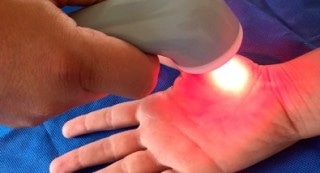Aug 30 2018
A new device that incorporates low-intensity laser light and therapeutic ultrasound substantially minimizes the pain experienced by patients with fibromyalgia.
 Medical device developed at the Optics and Photonics Research Center applies laser and ultrasound simultaneously with analgesic and anti-inflammatory effects (Image credit: release)
Medical device developed at the Optics and Photonics Research Center applies laser and ultrasound simultaneously with analgesic and anti-inflammatory effects (Image credit: release)
A scientific research has demonstrated that application to the palms rather than to tender points on different parts of the body has superior analgesic and anti-inflammatory effects. Owing to the pain reduction, patients also sleep better and are able to perform everyday tasks with less distress. Their general quality of life also increases.
In an article reported in the Journal of Novel Physiotherapies, scientists at the Optics and Photonics Research Center (CEPOF), one of the Research, Innovation and Dissemination Centers (RIDCs) supported by FAPESP, describe the concomitant application of low-intensity laser light and therapeutic ultrasound for three minutes to the palms of the hands of patients suffering from fibromyalgia. The treatment included ten twice-weekly sessions.
“The study describes two innovations: the device and the treatment protocol. By emitting laser light and ultrasound simultaneously, we succeeded in normalizing the patient’s pain threshold. Application to the palms differs from the focus on tender points found practically everywhere today in fibromyalgia care,” said Antônio Eduardo de Aquino Junior, a researcher at the University of São Paulo’s São Carlos Physics Institute (IFSC-USP) in Brazil and a coauthor of the article.
The study was also sponsored by the National Council for Scientific and Technological Development (CNPq) and the Brazilian Innovation Agency (FINEP).
The chief investigator for the project was Vanderlei Salvador Bagnato, Full Professor and Director of IFSC-USP.
In the research, 48 women aged 40-65 and diagnosed with fibromyalgia were split into six groups of eight at the Clinical Research Unit operated by IFSC-USP in collaboration with the Santa Casa de Misericórdia hospital in São Carlos, São Paulo State.
Three groups received applications of ultrasound or laser separately or combined in the area of the trapezius muscle. The other three groups received applications just to the palms.
The results revealed that treatment involving application to the palms was more successful irrespective of the method, but the laser-ultrasound combination considerably enhanced the patients’ condition. Assessments were done using the Fibromyalgia Impact Questionnaire (FIQ) and the Visual Analogue Scale for Pain (VASP).
A comparison of the groups exposed a variance of 57.72% in functionality improvement and of 63.31% in pain reduction for the ultrasound-laser group in the case of application to the trapezius. Ultrasound-laser application to the palms yielded a 73.37% variance in pain reduction compared with application to the trapezius.
Tender Points
The concept to test the effects of the new device in application to the palms of the hands came from a review of the scientific literature.
“Previous studies showed that patients with fibromyalgia had larger numbers of neuroreceptors near blood vessels in the hands. Some patients even had red points in this region. We, therefore, changed focus to test the direct action of the technique on these sensory cells in the hands rather than just so-called pain trigger points, such as the trapezius, which is typically very painful in fibromyalgia patients,” said Juliana da Silva Amaral Bruno, a physical therapist and the study’s first author.
The research revealed that application to the hands impacts all pain points in the patient’s body. The same group had earlier published an article in the Journal of Novel Physiotherapies illustrating a case study in applying the device to pain points. Although the results of this first research were agreeable, universal pain reduction proved difficult.
“Combined application of ultrasound and laser to pain points such as the trapezius was highly effective but did not succeed in reaching the other main innervations affected by the disorder,” Bruno said. “Application to the palms of the hands had a global result, restoring the patient’s quality of life and eliminating her pain.”
According to the research, the optimization of peripheral and brain blood flow via the stimulation of sensitive areas of the hands during the sessions regularized the patient’s pain threshold.
“It’s important to bear in mind that this isn’t a cure but a form of treatment that doesn’t require the use of drugs,” Aquino told Agência FAPESP.
Fibromyalgia is a chronic disease that involves extensive non-articular high-intensity pain lasting more than three months. It impacts 3% to 10% of the adult population, with a higher occurrence among women. Although patients undergo pain in almost the whole body, they do not present with inflammation, injuries, or tissue degeneration. Two other mysteries are related to fibromyalgia: its cause is unidentified, and no cure has been found thus far.
The typical treatment consists of anti-inflammatory and analgesic medication, physical exercise, and psychotherapy, as patients usually complain of extreme fatigue, dizziness, depression, difficulty concentrating, and anxiety.
According to Aquino, the new device that integrates laser and ultrasound therapy should enter the market in early 2019. It is presently being tested for other pathologies by scientists at CEPOF.
“We’re testing it for osteoarthritis, knees, hands, and feet, and the results have been interesting. Other projects are being designed for other diseases,” Aquino said.